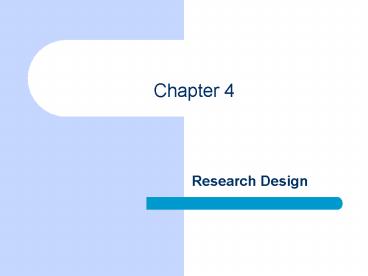Research Design - PowerPoint PPT Presentation
1 / 13
Title:
Research Design
Description:
Chapter 4 Research Design Chapter Outline Three Purposes of Research The Logic of Nomothetic Explanation Necessary and Sufficient Causes Units of Analysis The Time ... – PowerPoint PPT presentation
Number of Views:62
Avg rating:3.0/5.0
Title: Research Design
1
Chapter 4
- Research Design
2
Chapter Outline
- Three Purposes of Research
- The Logic of Nomothetic Explanation
- Necessary and Sufficient Causes
- Units of Analysis
- The Time Dimension
- How to Design a Research Project
- The Research Proposal
3
Three Purposes of Research
- Exploration
- Description
- Explanation
4
Purpose of Exploratory Studies
- Satisfy the researchers curiosity and desire for
better understanding. - Test the feasibility of undertaking a more
extensive study. - Develop the methods to be employed in any
subsequent study.
5
Criteria for Nomothetic Causality
- A statistical correlation between the two
variables. - The cause takes place before the effect.
- There is no third variable that can explain away
the observed correlation as spurious.
6
False Criteria for Nomothetic Causality
- While research can determine some causes, it
cannot determine complete causation. - Exceptions do not disprove a causal relationship.
- Causal relationships can be true even if they
dont apply in a majority of cases.
7
Necessary and Sufficient Causes
- Necessary cause represents a condition that must
be present for the effect to follow. - Sufficient cause represents a condition that if
present, guarantees the effect in question. - Causes that are necessary and sufficient are the
most satisfying outcome in research.
8
Units of Analysis
- What or whom to study
- Individuals
- Groups
- Organizations
- Social artifacts
9
Units of Analysis and Faulty Reasoning
- Ecological fallacy assuming something learned
about an ecological unit says something about the
individuals in the unit. - Reductionism reducing something to a simple
explanation when in reality it is complex.
10
How to Design a Research Project
- Define the purpose of your project.
- Specify exact meanings for the concepts you want
to study (conceptualize). - Choose a research method.
- Decide how to measure the results.
11
How to Design a Research Project
- Decide whom or what to study.
- Collect empirical data.
- Process the data.
- Analyze the data.
- Report your findings.
12
Elements of a Research Proposal
- Problem or objective
- Literature review
- Subjects for study
- Measurement
13
Elements of a Research Proposal
- Data-collection methods
- Analysis
- Schedule
- Budget































